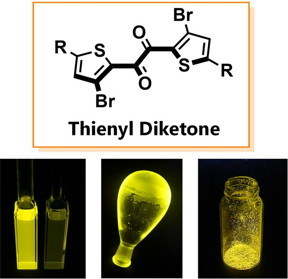Home > Press > New organic molecule shatters phosphorescence efficiency records and paves way for rare metal-free applications
 |
| Chemical structure of the molecule and photographs of phosphorescence taken under UV irradiation.
CREDIT Osaka University |
Abstract:
A research team led by Osaka University discovered that the new organic molecule thienyl diketone shows high-efficiency phosphorescence. It achieved phosphorescence that is more than ten times faster than traditional materials, allowing the team to elucidate this mechanism.
New organic molecule shatters phosphorescence efficiency records and paves way for rare metal-free applications
Osaka, Japan | Posted on July 5th, 2024
Phosphorescence is a valuable optical function used in applications such as organic EL displays (OLEDs) and cancer diagnostics. Until now, achieving high-efficiency phosphorescence without using rare metals such as iridium and platinum has been a significant challenge. Phosphorescence, which occurs when a molecule transitions from a high-energy state to a low-energy state, often competes with non-radiative processes where the molecule loses energy as heat.
This competition can lead to slow phosphorescence and lower efficiency. While previous research indicated that incorporating certain structural elements into organic molecules could speed up phosphorescence, these efforts have not matched the speed and efficiency of rare metal-based materials.
The research teams breakthrough with the new organic molecule thienyl diketone represents a significant advancement in the field. Yosuke Tani, senior author of the study, remarked, “We discovered this molecule by chance and initially did not understand why it demonstrated such superior performance. However, as our research progressed, we began to connect the pieces and deepen our understanding.”
“Our research has led to a clearer understanding of the mechanism behind this molecules performance than any previous organic phosphorescent material, explains Dr. Tani. Nonetheless, we believe there is still much to explore, and we are excited about its potential applications.”
This research provides new design guidelines for developing organic phosphorescent materials that do not rely on rare metals, offering the potential to surpass and replace these materials in various applications. The findings promise significant advancements in the fields of OLEDs, lighting, and medical diagnostics, among others.
####
About Osaka University
Osaka University was founded in 1931 as one of the seven imperial universities of Japan and is now one of Japan’s leading comprehensive universities with a broad disciplinary spectrum. This strength is coupled with a singular drive for innovation that extends throughout the scientific process, from fundamental research to the creation of applied technology with positive economic impacts. Its commitment to innovation has been recognized in Japan and around the world. Now, Osaka University is leveraging its role as a Designated National University Corporation selected by the Ministry of Education, Culture, Sports, Science and Technology to contribute to innovation for human welfare, sustainable development of society, and social transformation.
Website: https://resou.osaka-u.ac.jp/en
For more information, please click here
Contacts:
Saori Obayashi
Osaka University
Office: 81-661-055-886
Copyright © Osaka University
If you have a comment, please Contact us.
Issuers of news releases, not 7th Wave, Inc. or Nanotechnology Now, are solely responsible for the accuracy of the content.
Display technology/LEDs/SS Lighting/OLEDs
![]()
Efficient and stable hybrid perovskite-organic light-emitting diodes with external quantum efficiency exceeding 40 per cent July 5th, 2024
Organic Electronics
![]()
Efficient and stable hybrid perovskite-organic light-emitting diodes with external quantum efficiency exceeding 40 per cent July 5th, 2024
News and information
![]()
Single atoms show their true color July 5th, 2024
![]()
New method cracked for high-capacity, secure quantum communication July 5th, 2024
![]()
Searching for dark matter with the coldest quantum detectors in the world July 5th, 2024
![]()
Atomic force microscopy in 3D July 5th, 2024
Possible Futures
![]()
New method cracked for high-capacity, secure quantum communication July 5th, 2024
![]()
Searching for dark matter with the coldest quantum detectors in the world July 5th, 2024
![]()
Atomic force microscopy in 3D July 5th, 2024
Discoveries
![]()
Efficient and stable hybrid perovskite-organic light-emitting diodes with external quantum efficiency exceeding 40 per cent July 5th, 2024
![]()
A New Blue: Mysterious origin of the ribbontail rays electric blue spots revealed July 5th, 2024
![]()
Single atoms show their true color July 5th, 2024
![]()
New method cracked for high-capacity, secure quantum communication July 5th, 2024
Announcements
![]()
Single atoms show their true color July 5th, 2024
![]()
New method cracked for high-capacity, secure quantum communication July 5th, 2024
![]()
Searching for dark matter with the coldest quantum detectors in the world July 5th, 2024
![]()
Atomic force microscopy in 3D July 5th, 2024
Interviews/Book Reviews/Essays/Reports/Podcasts/Journals/White papers/Posters
![]()
Single atoms show their true color July 5th, 2024
![]()
New method cracked for high-capacity, secure quantum communication July 5th, 2024
![]()
Searching for dark matter with the coldest quantum detectors in the world July 5th, 2024
![]()
Atomic force microscopy in 3D July 5th, 2024










